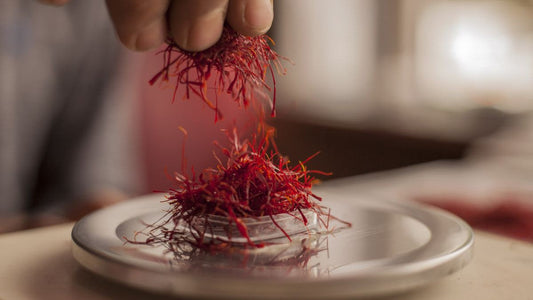How to Identify High-Quality Saffron
Ara OhanianShare
Saffron, often referred to as "red gold," is a highly prized spice used for its unique flavor, aroma, and vibrant color. Given its high value, it's essential to distinguish genuine, high-quality saffron from inferior or fake products. Here’s a comprehensive guide on identifying the best saffron for your culinary and medicinal needs.
Understanding Saffron Grades
1. Super Negin (Premium Quality)
- Description: Super Negin consists of the longest and thickest saffron threads, offering superior color and flavor. It's considered the best quality available, with a higher concentration of crocin, picrocrocin, and safranal.
- Usage: Ideal for gourmet dishes and luxury culinary applications.
2. Sargol (Top Quality)
- Description: Sargol, meaning "top of the flower" in Persian, consists of the red stigmas without any yellow styles. This grade is known for its strong color and intense aroma.
- Usage: Ideal for high-end culinary applications and traditional medicines.
3. Pushal (Second Grade)
- Description: Pushal saffron includes both the red stigmas and some yellow styles. It's less potent than Sargol but still of high quality.
- Usage: Commonly used in cooking and home remedies.
4. Bunch (Third Grade)
- Description: This grade contains a mix of red stigmas and yellow styles, bundled together as harvested. It has a milder flavor and aroma.
- Usage: Suitable for dishes where saffron is not the main flavor component.
Physical Characteristics of High-Quality Saffron
1. Color
- Vibrant Red: High-quality saffron stigmas are deep red, with a slight orange tip.
- Uniformity: The threads should be evenly colored without white or yellow streaks.
2. Aroma
- Distinctive Fragrance: Genuine saffron has a sweet, floral aroma with hints of honey and hay. A metallic or musty smell indicates poor quality or fake saffron.
3. Taste
- Bittersweet Flavor: Authentic saffron offers a unique bittersweet taste, slightly earthy and not overly sweet.
4. Moisture Content
- Dry but Pliable: Quality saffron is dry but not brittle. Overly dry saffron can indicate age or improper storage.
Testing Saffron Quality at Home
1. Water Test
- Procedure: Place a few saffron threads in warm water or milk. High-quality saffron will release its color slowly, turning the liquid golden yellow without losing its red color immediately.
- Interpretation: If the water turns red quickly, it's likely dyed or fake saffron.
2. Aroma and Taste Test
- Procedure: Crush a few threads between your fingers and smell. Brew a small amount in hot water and taste.
- Interpretation: The aroma should be strong and pleasant, and the taste should be slightly bitter. Lack of aroma or an overly sweet taste suggests low quality or adulteration.
Certifications and Origin
1. Geographical Indications
- Iranian Saffron: Known for the best quality due to ideal growing conditions.
- Kashmiri Saffron: Highly prized, though less available.
- Spanish Saffron: Recognized for its distinct flavor, often labeled with a PDO (Protected Designation of Origin).
2. ISO Certification
- ISO 3632: This standard measures saffron quality based on color, aroma, and flavor. Look for saffron with a high ISO rating for assurance of quality.
Common Adulteration Practices
1. Color Enhancement
- Synthetic Dyes: Inferior saffron or other substances dyed to mimic saffron’s red hue.
- Detection: Perform the water test; dyed saffron will bleed color rapidly.
2. Mixing with Other Substances
- Safflower or Turmeric: Often used to bulk up saffron.
- Detection: Examine the threads closely; safflower is more orange and lacks the characteristic aroma.
Saffron Purchasing Tips
1. Trusted Suppliers
- Reputable Brands: Purchase from well-known brands or suppliers with positive reviews and transparent sourcing practices.
- Certified Organic: Look for organic certification to ensure no chemical additives or pesticides.
2. Packaging
- Airtight Containers: Saffron should be stored in airtight containers to preserve its quality.
- Opaque Packaging: Protects saffron from light, which can degrade its quality.
Saffron Storage and Handling
1. Storage Conditions
- Cool and Dark Place: Store saffron in a cool, dark place to maintain its potency.
- Avoid Moisture: Keep it dry to prevent mold growth and loss of flavor.
2. Shelf Life
- Optimal Use: For best results, use saffron within one to two years of purchase.
Conclusion
Identifying high-quality saffron involves examining its physical characteristics, conducting simple tests, and purchasing from reputable sources. By understanding the different grades and the common adulteration practices, you can ensure that you’re using the best saffron in your culinary and medicinal applications. Always store saffron properly to maintain its exceptional qualities.
FAQ: Identifying High-Quality Saffron
What are the different grades of saffron? The grades of saffron include Super Negin (premium quality), Sargol (top quality), Pushal (second grade), and Bunch (third grade).
How can I test saffron quality at home? Use the water test (place threads in warm water; quality saffron turns the water golden yellow slowly) and the aroma and taste test (crush and smell for a sweet, floral aroma; taste should be slightly bitter).
What are common adulteration practices? Common practices include color enhancement with synthetic dyes and mixing with substances like safflower or turmeric.
What should I look for when purchasing saffron? Buy from reputable suppliers, look for organic certification, and choose saffron stored in airtight, opaque packaging.
How should saffron be stored? Store saffron in a cool, dark place in an airtight container to maintain its quality and potency.
How long does saffron last? For optimal results, use saffron within one to two years of purchase.




